The 2024 Student Writing Contest drew more than 1,000 submissions, with at least one entry from every US state. Winning authors will receive cash prizes, and the first-place entries will be on display in Unknown Sitters, an exhibition on view at 520 Royal Street from April 5 through October 6. Congratulations to the winners and thank you to all who entered!
ELEMENTARY SCHOOL PORTRAIT 1
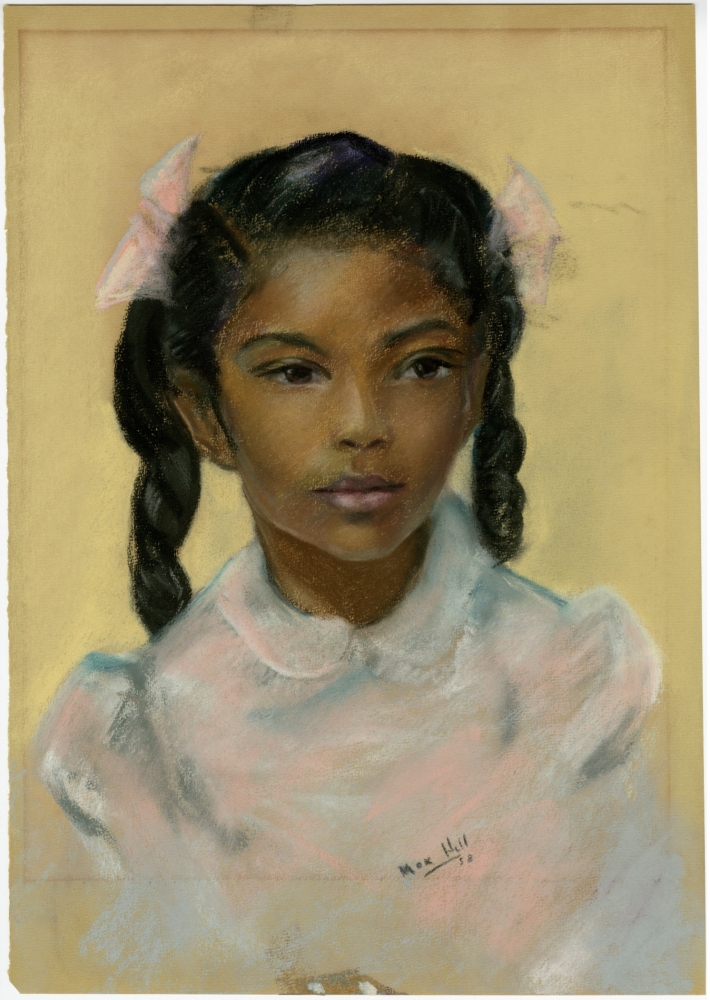
Young girl with pink bows; 1958; by Max Hill; 2007.0388.27
FIRST PLACE
The Mirror
by Ava Luangkesorn, 4th grade
Franklin Elementary School, Sewickley, PA
She sees,
A little skinny Black girl and her charcoal eyes.
She sees,
A girl of truth, with no need of lies.
She sees,
A girl with hope inside.
She sees,
A girl with a big mind, but small in size.
She sees,
A girl with fear and braided hair.
She sees,
A girl who obeys and accepts to make things fair.
She sees,
A girl taking on challenges to go live a proper life.
She sees,
A girl that has a dress the color of rice.
She sees,
A lovely child, with sepia skin.
She sees,
A child who understands the hymn.
She sees,
Truth and lies. Fate be told.
She sees,
A girl who can’t wait to watch a story unfold.
She sees,
A girl afraid of being attacked.
She sees,
A girl scared of not being in a pact.
She sees,
Herself, in a mirror, holding back tears.
She sees,
Herself, in a mirror, waiting for this moment, in so many years.
She knows,
That she’s not interested in the front seat ticket on the bus pass.
She knows instead,
That she has ambitions to sit in the front row desks in the class.
SECOND PLACE
Ruth and Ruby
by Trinian Faulkner, 3rd grade
Our Lady of Overton Homeschool, Mountain Brook, AL
A little girl, her name is Ruth.
She always liked to live in Truth.
She was there that day when Ruby Bridges walked in school.
And thought that Ruby was brave and cool.
“If she can do it, so can I
And I’m not going to weep and sigh.”
She heard the crowd shout and yell
Throwing things she could not tell.
She went home with her mom and dad
And she then told them she’d be glad
To go to school like Ruby did
Even though she was just a kid.
The next morning, Ruth got dressed in white
And she hoped that her shoes were not too tight.
She got pink bows and put them in her hair
And she looked beautiful and so very fair.
Her dress was as soft as silk
The color of pure white fresh milk.
She walked to school and felt pretty and brave
She took a deep breath and gave a big wave.
THIRD PLACE
A Big, Little Change
by Isla Jane Ozerden, 3rd grade
Bayou View Elementary School, Gulfport, MS
Hi, I go to a white only school,
And all the other kids are very, very cruel,
Which I don’t think is very cool.
Then a painter named Max Hill hung me up on a wall
And then all the kids laughed at me because I was so tall!
But then one day everything changed!
All the Black children got rearranged
Across town to a white-only school!
And now everything is pretty cool.
So now segregation has ended
And now our school is all blended.
And now I am most proud to be
A little Black girl called Georgia Crosby.
ELEMENTARY SCHOOL PORTRAIT 2
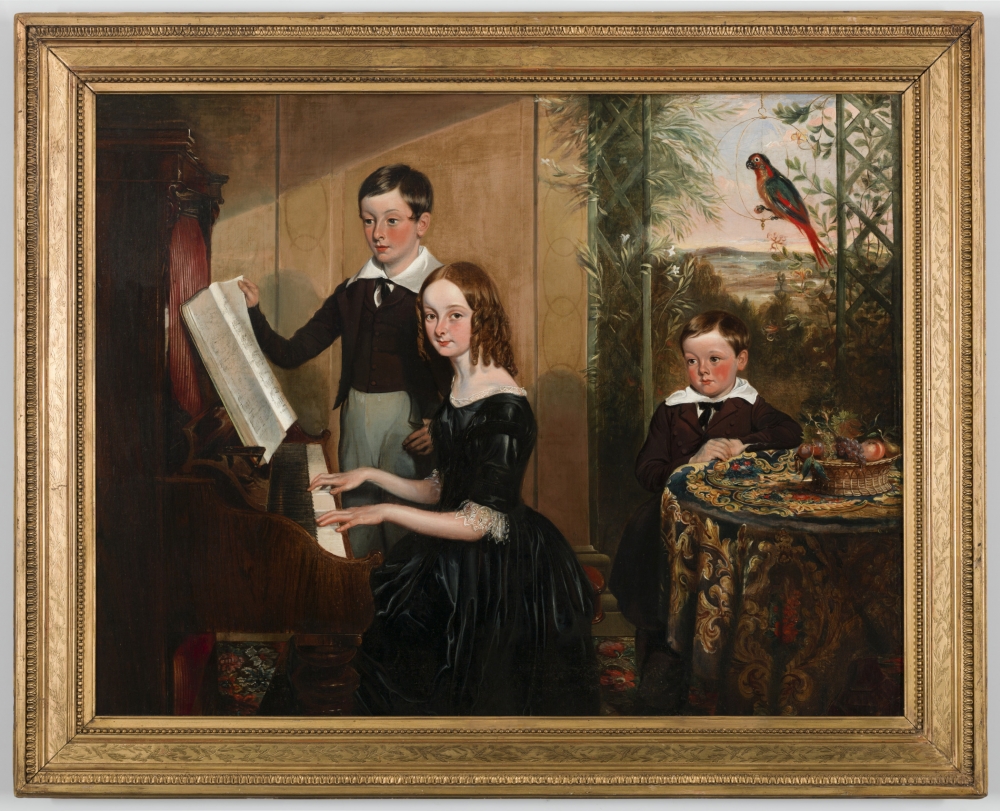
Children at the piano; 1840–1850; by Charles Octavius Cole; 1993.56
FIRST PLACE
Lisa, Tomie, and Michael
by Quinn Powell, 3rd grade
Walker Elementary School, McKinney, TX
This is Lisa. She is the girl playing the piano. She is annoyed that her brother is turning the piano pages before she is ready. The young boy, Tomie, is sad that he cannot play outside if his siblings aren’t out with him. Tomie is also sad because Lisa won’t let him feed fruit to the parrot. The parrot’s name is Carrot and he is sleeping with his eyes open. Michael, the older boy, is really mischievous. That’s why he is turning the pages so fast! Later in the afternoon, at dinner, they have fruit salad for dinner and Tomie sneaks off to feed fruit to Carrot.
SECOND PLACE
The Cole Family
by Quinn Ho, 5th grade
Gretna No. 2 Academy for Advanced Studies, Gretna, LA
Today my father painted me and my siblings,
I hope it brings him joy if one of us leaves.
We were all very willing,
“Lots of time” father said he needs.
And then I watched my siblings,
My sister playing piano,
The food I was nibbling,
And my brother flipping pages while my mind goes
My mind goes to the thought of my illness.
While my siblings play,
I’m stuck with my sickness
And I think of another way.
Another way to live.
To be happy and to not be sick.
To the sickness, I cannot forgive.
The sickness in my bed, the scent thick.
To play piano or be sick, I didn’t want either,
So sick I always need to take a breather,
What am I sick with?
The Yellow Fever.
—Poem written by James Cole days before his death from Yellow Fever
THIRD PLACE
Three White Children
by Bao Desporte, 5th grade
Gretna No. 2 Academy for Advanced Studies, Gretna, LA
I painted three young children today. There were two young boys and a young girl. The girl was the most social, stating that she was Elizabeth Charles and the boys, James and George, were her brothers. Her older brother, James, taught her piano. Her family was happy, until their parents died of yellow fever. She stated that she was twelve, James was fifteen, and George was five when this happened. I was stunned at this fact, as they were so young when it happened. They wanted to be painted to be remembered if they died. They didn’t want to be alone, and I couldn’t help but feel bad for them. Each stroke I took was a step closer to helping remember them. As I finished the painting, Elizabeth started crying and pouring out her feelings to poor James, but I did not focus on that and finished my final strokes. When I showed the painting to them, they smiled at it. Elizabeth was the happiest, saying, “Thank you, sir.” As they left, I saw the smile disappear from her face and she started crying again. I wonder who would buy this.
—Taken from the Diary of Charles Cole
ELEMENTARY SCHOOL PORTRAIT 3
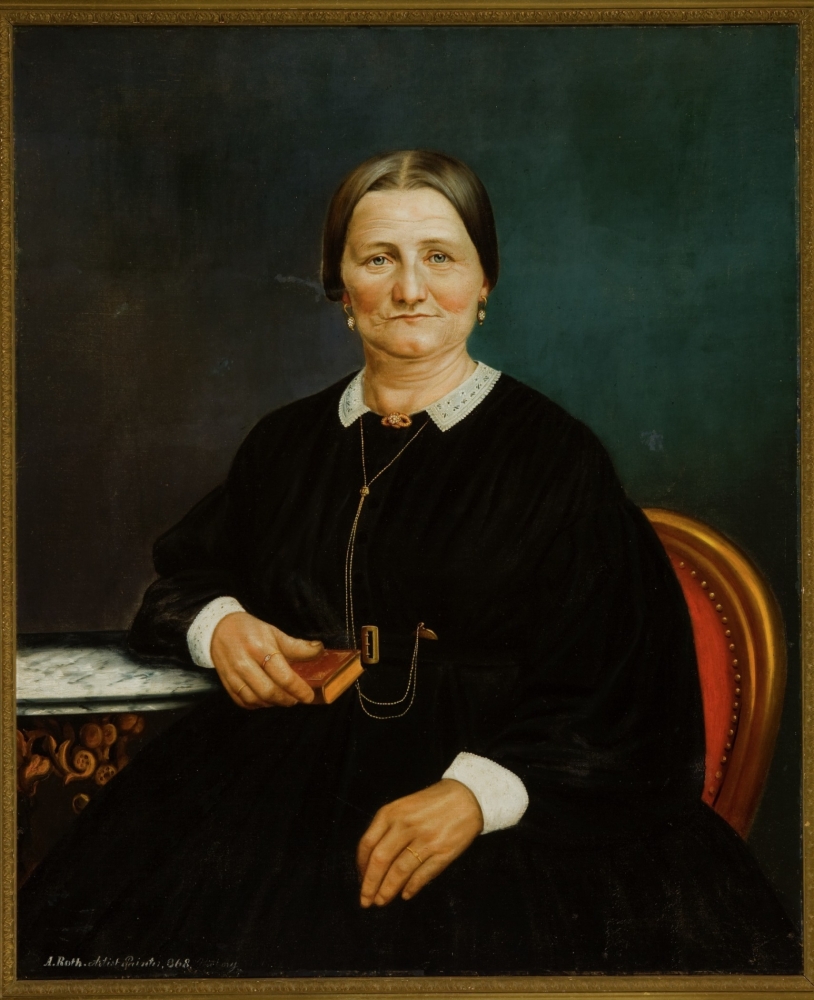
Woman in a red chair; 1867–1869; by Andrew Roth; 1987.177
FIRST PLACE
The Black Coffin
by Cooper Kennedy, 4th grade
Episcopal School of Acadiana, Lafayette, LA
The wagon rode swiftly across the road. It was hard to see Ms. Truman in her black dress in the darkness of night. She sat next to a tall man. In the back of the wagon was a black coffin. The two riders did not speak. Ms. Truman looked at her watch nervously.
Up ahead they saw two soldiers. One of the soldiers says, “Where are you going so late?” Ms. Truman says, “I am bringing my husband to the family cemetery.” The guard says, “Is it really your husband or is it something illegal?” Ms. Truman says, “You can take a look in the coffin, but I am warning you he died of yellow fever just two days ago.”
The soldiers waved them through.
As the clock reached midnight they saw two men and three horses. The men were wearing all black. She looked in her book and asked, “are you Mr. Sullivan?” He nodded.
She reached back and knocked on the coffin. A man climbed out and walked to the third horse. The three men rode off into the night.
The driver looked at Ms. Truman and smiled. She smiled back at Mr. Truman.
SECOND PLACE
The Lost Letters of Madame Edith LeBlanc
by Colsson Layne, 3rd grade
Homeschool, Mobile, AL
February 12, 1860
Dear Mr. Fred Koeniger,
I have sent this letter to request the presence of Madame Koeniger at our 3rd annual Distinguished Ladies of New Orleans Tea Party. Can we count on your donation of delicious beignets and famous coffee and chicory for the event? Last year the Governor’s wife said she would be looking forward to Cafe Du Monde’s treats. All the proceeds from this event will benefit the young girls here at Madame Edith’s home for girls. The tea party will take place at John Burnside’s Robb Mansion on May 16th at high noon.
Sincerely,
Edith LeBlanc
April 30, 1864
My dear Captain LeBlanc,
I hope this war will end soon so you can come home. I miss you.
With all my heart,
Edith LeBlanc
August 29, 1878
Dear Doctor Louis,
My students and I are facing hard times at Madame Edith’s home for girls. For as you know, there is a massive yellow fever epidemic and I believe that lots of my girls will not survive it. Captain LeBlanc and I have lost 3 girls already. Have you found any answers? Please respond soon.
Sincerely,
Edith LeBlanc
THIRD PLACE
The Unknown Person
by Emery Munchak, 3rd grade
Academy of the Sacred Heart, New Orleans, LA
Long long ago in a town far away the old judge Ruth Osberg was in need of help. She was getting old, and she needed someone to take her place. As she walked through the hall she remembered how she became a judge it was a long time ago when women weren’t allowed to be judges. It took many years to become a judge and many days of crying. She became a judge by sneaking into the court at night. There she placed a picture of herself and a message saying she really wanted to be a judge. After that night, the people let her be a judge. They realized that if she was brave enough to sneak into a court, she was brave enough to handle a case.
MIDDLE SCHOOL PORTRAIT 1
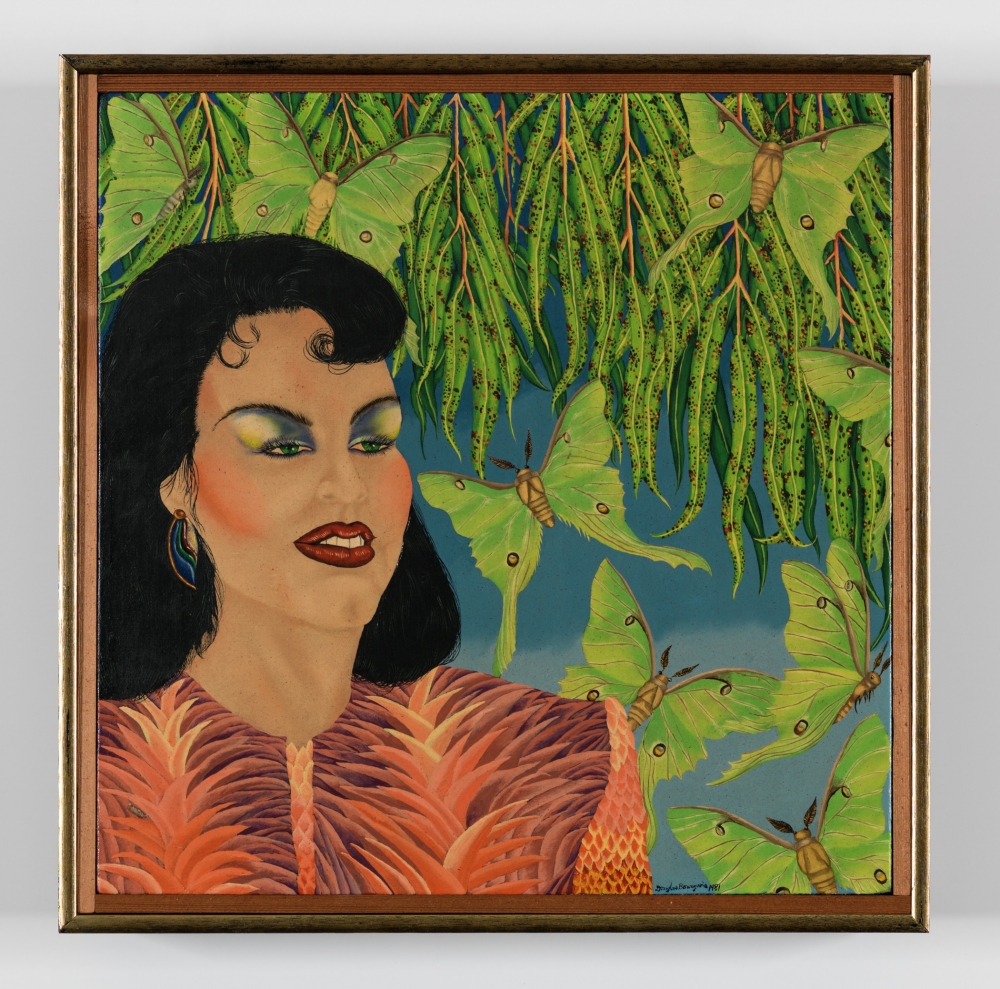
Emerald Eyes and Luna Moths; 1981; by Douglas Bourgeois; 2018.0253.14
FIRST PLACE
The Lady That Is Just Not Fit
by Eloise Ritter, 6th grade
The Willow School, New Orleans, LA
I am the moth. Pest like and infuriating. I try to be pretty but don’t succeed. Too hairy with alien eyes. I want to be the best, but am easily defeated. Unlike the much-loved butterfly, I am just not in people’s sights. My colors too drab, wings too bulky. Still, I flap wildly. I am awake at night but love the light.
I am the queen. As regal as one like me can be. Makeup bold and bright. Outlandish. Camouflaging what’s underneath. Orange and pink streaking my cheeks. Shocking eyes and lips. Mismatched with intention. I stand out. Bulging. But I am still stuck inside. I am different, but not in the way they believe. Transform from moth to butterfly. I am made up.
SECOND PLACE
The Woman in the Pink Leafed Dress
by Zara Ahmed, 6th grade
The Willow School, New Orleans, LA
I am looking across the room at a beautiful woman, sitting to have her portrait painted. She’s dressed in bright colors: a peach dress with a leaf design and bright blue and yellow makeup. Her face is inquisitive, her eyes wandering about the room taking in as much detail as possible. I can almost see her brain working to analyze me and her painter, the other two people in the room.
I, as the artist assistant, am running around retrieving my boss’ paints and brushes he needs next. While I am working to find his set of pastel acrylics, I think of the stories told about this woman. Her name is Lilith. There has been much said about her, by many.
Some say that she is very cunning and deceitful, vain and rightfully so. She knows how to get one to do things for her, to trick them to do her bidding. She analyzes those around her to find their weaknesses to get under their skin. She does not hold back, shows no remorse.
Beware the woman in the pink leafed dress.
THIRD PLACE
Grimacing Woman
by Miriam Rudman, 6th grade
Isidore Newman School, New Orleans, LA
I sit, smiling. My butterflies stay in one place, their green and yellow wings on display. The green hanging fronds above me would be swaying, but we all sit still while the museum is open. A little girl and her mother stand in front of me. The little girl wears a yellow dress. She tugs at her mothers arm, “Mommy, let’s go.”
They exit, and the lights go out. I relax my face gratefully. My butterflies fold their wings. The portrait next to me sighs and smooths out her long dress. I groan. “I feel so weird, Mary. Like I don’t belong here.” As her mouth opens when the lights turn on and she stills and smiles. Now I see why. A girl walks in. Quickly I freeze, but she notices. “You’re alive?” she says.
I inwardly condemn myself. Why did I let her see this? But . . . maybe I could have a confidant. Someone to talk to. I sigh. What have I got to lose? I say, “Yes, I am.”
We converse all night. In the morning the museum opens and I smile my first real smile in a while. By talking to someone, I belong.
MIDDLE SCHOOL PORTRAIT 2

Two men, possibly father and son; 1840–1860; by Jules Lion; 2021.0264
FIRST PLACE
Father and Son
by David L. Taylor, 8th grade
KIPP Morial School, New Orleans, LA
Jules led us to the small stool in the middle of the room. We sat behind a landscape backdrop, as my father rested his hand around me. The simplest things he would do would become so, aggravating to me. For a moment in time it felt he truly despised me, and it was no secret. For the few times he had looked at me during my childhood . . . he never truly acknowledged. Despite me being a free person of color it seemed he only saw the black blood that was interwoven within me. He always felt hatred towards my people, he even considered selling me off when I was a child to one of the local slave markets in those . . . horrid quarters. I began to hate him as—“Well, How would you two gentlemen like me to paint you as?” His question made me remember why I agreed to have this painting done. My father, in his older age, had begun to . . . change. He finally began to see me as a genuine and even kind person outside of my color. I agreed to take this offer, if it truly meant I could start anew with my father, that I could eventually become comfortable with the idea of us even being remembered as, “Father and Son, paint us as father and son.”
SECOND PLACE
Belonging
by Siri Panchumarthi, 7th grade
The Hockaday School, Dallas, TX
A blue silk cravat that he picked out,
The ruby ring, to share his wealth
A welcome entry into the main house
I held this man, my owner, my father
A white man.
And I, his half black son.
The fine wool coat rubbing against my skin,
A dark hand over a pale one
Hair curled up, imitating his
No longer a castaway, unlike the rest
A white man.
And I, his half black son.
Standing still, posing for the painter,
Thoughts running wildly; fortunes turned
I could have remained unclaimed
But for the man next to me
A white man.
And I, his half black son.
To not be seen by anyone, but if they did,
It would be the prestigious plantation owner
And the fortunate slave, made overseer
To me, now, he is my father
A white man.
And I, his half black son.
The portrait, dusty, hanging unseen in the attic
But when time has passed and slavery is long gone,
Someone would see the exception in the South
The embrace of the present, a belonging, of
A white man.
And I, his half black son.
THIRD PLACE
New Orleans, 1860
by Jaxson Erwin, 8th grade
Learning Steady Academy, Lampasas, TX
Solomon: I’m sure looking good for this picture. I know dad wishes he still
had his hair. I wish he’d wear his wig; he’s embarrassing me!
Gestaff: Solomon would you quit moving so much; stop messing with your hair!
Solomon: You’re just jealous that you can’t because you don’t have any.
Gestaff: Uhm, for your information my hair is great for my age. A lady complimented me yesterday.
Solomon: Either that or she was making fun of you.
Gestaff: Let’s change the subject. Smile for the picture.
Gestaff: I wonder if he’s almost finished painting. I can’t feel my legs. My joints hurt.
Solomon: I hope Mom’s not too mad. I’m sure she’s realized I was too lazy and didn’t do my chores by now.
Gestaff: Quit complaining, I’m too old for this. I’ve done way too many pictures with this num nut!
Solomon: Dad, can we go? I can’t bear this any longer. Wait, did we tell the man with our carriage we would be done at 1:00. How are we going to get back home?
Gestaff: Well, I guess we’re walking home. You sure don’t like to think a lot do you son?
MIDDLE SCHOOL PORTRAIT 3
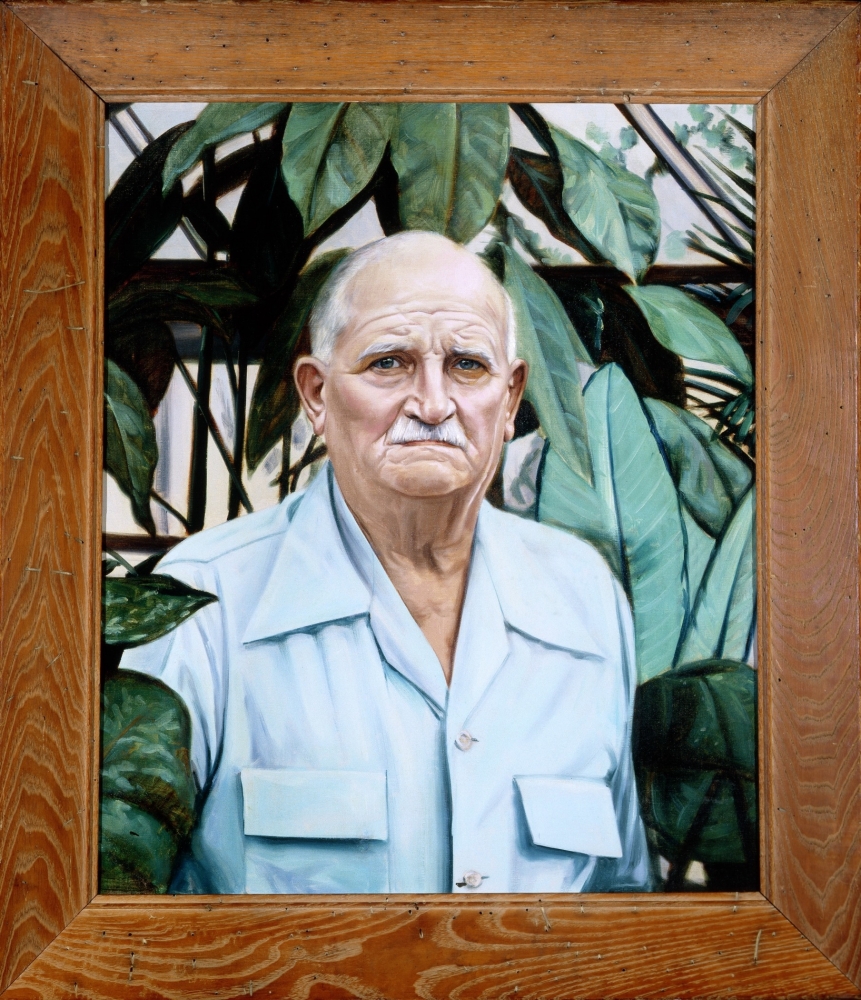
Man among leaves; 1945–1950; by Howard Newton Reeve; 1996.88
FIRST PLACE
Rising Writer
by Ellie Dilligan, 8th grade
Morris Jeff Community School, New Orleans, LA
Wallace Van Moneybags came from a ridiculously wealthy family. But, unlike other rich children, Wallace didn’t grow up living in the glorious mansions on Audubon Place, spending the evenings playing with gold bricks and riding albino alligators. No, Wallace grew up in the garden shed behind his family’s mansion, hidden from the world due to his incredibly premature balding. Wallace started balding at age five, due to the shock from a particularly frightening experience involving a mischievous giraffe at the local zoo. And so, Wallace grew up in the shadow of his siblings, who were blessed with luscious golden hair resembling that of a blonde Oompa Loompa. He was a soft spoken, thoughtful child, and he had an ardent love for reading. Whenever he wasn’t tending to his family’s magnolia trees, he would bury his nose into any book he could get his hands on. He was always jealous of the characters in those books. They had hair and went on adventures. Nowadays, Wallace works at Oxford University as a gardener, and he takes pride in his work. He spends his days tending the plants and writing a novel featuring a bald protagonist.
SECOND PLACE
Thomas James Edward
by Rocco Marino, 6th grade
The Willow School, New Orleans, LA
He was a young boy born in the booming city of New York in the 1910s.
He grew up as a troubled child and was involved in many neighborhood gang brawls.
When he was 14 his mother died.
When his father tried to remarry, Thomas got upset that he was bringing another woman into his mom’s home.
His father chose the woman.
Thomas rode the streets, hopping from city to city until he found a proposal,
If he enlisted, he would get a roof over his head and would see the world.
They'd take him to a training camp in Europe.
This was one of the worst decisions of his life.
The conditions were grueling
Although he was one of the best in his platoon.
Which everyone praised him for, but he hated it.
Pulling the trigger on a gun became a nightmare for him.
A year later, he was discharged with a injury from bomb-shrapnel
His father praised him as a war hero
His step-mother had arranged a marriage for him
Within days, he got married.
He went down south to New Orleans.
Atlast, He finally found peace.
THIRD PLACE
The Man on Magazine Street
by Kaejha Stewart, 6th grade
A. E. Phillips Laboratory School, Ruston, LA
There was this man, I knew
His name was Mr. Lou
He was the nicest guy on the street
He smiled to new friends he’d meet.
And at the top of his roof
He’d grow plants, tall as Jack’s Beanstalk, I have proof.
And when the night hushed the city
His cat meowed loudly, she was really pretty.
Hopping ’cross rooftops ’til morning came
Where she’d go back home to play a little game.
Mr Lou, always filled with joy, just like the sweetest honey
His personality, worth more than money.
Blue shirt, no tie, topped with a grin
When you meet him, only then will the fun begin
Mr. Lou, he may have looked mean
But I’ve seen another side, filled with grass that’s green
Worked for the Air Force that man
Doing anything for his sacred land.
He was never married, far as I knew
Moved around for his country, never knowing what it felt
like to love and start anew
He was not like any another man you’d meet
But this was the man, the man on Magazine Street
HIGH SCHOOL PORTRAIT 1
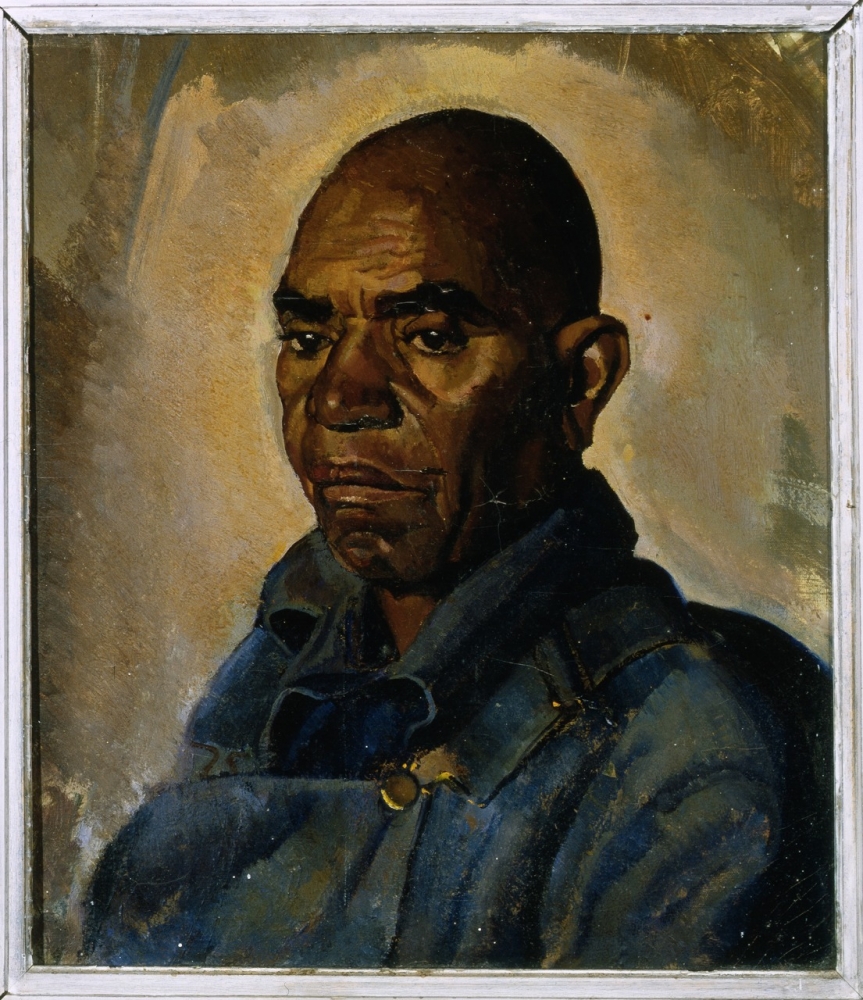
Man in overalls; 1930–1935; by Daniel Webster Whitney; 1984.231.7
FIRST PLACE
The Man in the Portrait
by Kyrie Melancon, 9th grade
Frederick A. Douglass High School, New Orleans, LA
I work days and nights at the riverfront unloading ships as they come through the port of New Orleans. I’m hardly home to see my family. One night when I was walking home from the River, a Creole man offered to paint my portrait for so much money that maybe I could take a day off and spend it with my family. So, I accepted the deal even though I was exhausted. I followed the man to an alleyway where I was told to sit in front of a brown building. I sat there for hours thinking. I started to realize my whole life I’ve sacrificed myself to take care of the people I love. I am proud knowing that the hard work I do would never be pushed onto my children. I am proud of what I accomplished. I know I would never have the life I dreamed of having but I knew it would all pay off when my children will be telling the next generation about the good man I am.
SECOND PLACE
The Stoic Man
by Cate McCammon, 9th grade
Academy of the Sacred Heart, New Orleans, LA
The man sits there stone-faced, he has barely said a word to me for the entire session, other than to confirm who I am. That is nothing new or surprising, the far off look in his eyes suggests he might be a veteran. However now it seems he works every day, hopefully never to see war again. I think he might be a farmer. He looks weathered enough, as if he spends a lot of time in the sun. His clothes appear shabby, but well made, and he holds himself like a man who knows his worth. I can’t help but wonder if he has a family, maybe some sons and daughters, and a wife whom he loves. Or maybe he lives alone, having lost his family or never was given the chance to have one.
THIRD PLACE
True Blue
by Kingston Johnson, 9th grade
Frederick A. Douglass High School, New Orleans, LA
Those true blue overalls
Stained with living
Oh those overalls
Smudged with giving
Eyebrows full of sorrow
Stern facial structure
Somber thinking of tomorrow
But his tears would never rupture
Lived many lives
The Present and the past
A hardworking man
One with the grass
“Don't cry!” Daddy said
“Wipe your tears.” Momma soothed
His soul lived in the city
His emotions in the grooves
Each perfectly sculpted furrow
Is a perfectly written story
Some about how this city had hurt him
Others about how New Orleans brought him glory
His golden buttons
They did once shine
Many he has lost
From the hands of time
His sanctuary lived in the farm
Where the carrots and potatoes grew
His love for the farm so tall
His fondness is deep as roux.
And after all of that life
Two things follow through
His love for that farm
And those overalls?
True blue.
HIGH SCHOOL PORTRAIT 2
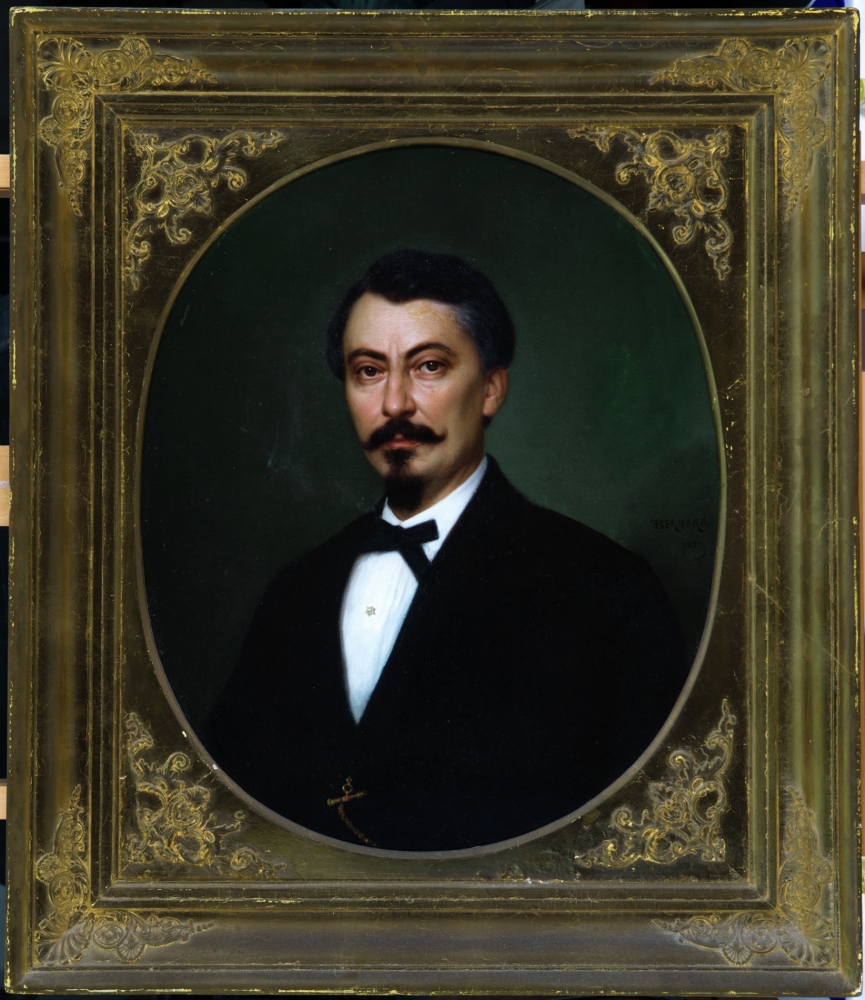
Creole gentleman; 1870; by François Bernard; 1997.120.8
FIRST PLACE
The New Orleans Vampire
by Jayden Bergeron, 12th grade
Zachary High School, Zachary, LA
I let the woman’s limp body drop as I finish my meal. I do not know her name or her story. All I know is that she doesn’t belong here. I only take the lives of newcomers to the city. New Orleans is not for them. I feel no trace of anxiety as I leave the woman’s home and step onto the busy New Orleans street. The key is to walk with confidence. A guilty face reveals a guilty conscience, and that’s what gets you in trouble. Once home, I hurriedly retreat to my bedroom to change from my work clothes into my nicest suit. I cannot look disheveled for my annual birthday portrait. I complete a quick combover of my hair and finish adjusting my mustache just as I hear a knock at my door. Artist François Bernard stands on the other side, smiling as I open the door to greet him.
“Mr. Gerard Trudeau, I presume?” he asks with a smile.
“Yes, welcome!” I reply, almost feeling bad, knowing his fate.
Can you really blame me? A man has to eat.
SECOND PLACE
Strained Ambition
by Phoebe Fannin, 10th grade
Zachary High School, Zachary, LA
“146 Customhouse Street, above the bookshop,” the man repeated to himself as he strode through the bustling streets of New Orleans. He walked quickly, and he walked with confidence. His destination was the studio of François Bernard, a French-born artist who had been recommended by a colleague. According to the colleague, Monsieur Bernard’s portraits were as exact as photographs. The man appreciated exactness. After all, where would he be without it? He neared the address of the studio and climbed the stairs outside of the building. He paused before knocking on the door. “Is this worth it?” he thought to himself. “I will spend hours sitting for this portrait. Hours that I will never get back. Time is money.” He immediately chided himself for such thoughts. Everyone who was anyone in New Orleans had portraits, and those people did not worry about lost time. They certainly never worried about lost money. So, neither would he. Thrift was beneath him now. It had been for a long time. He knocked on the door to the studio, and the painter opened it. The man said, “I am here to sit for a portrait. As realistic as possible. Spare no expense.”
THIRD PLACE
Consequently Curious
by Ellie Hardie, 11th grade
Mount Carmel Academy, New Orleans, LA
Edmund Archambeau was the ambitious type—hardworking, mostly successful, but at the times he failed, he became truly vindictive. Thriving during the 1870’s, Archambeau’s oil company, Archambeau Oil (he struggled with creativity), was extremely lucrative, producing enough oil that Edmund Archambeau lived in excessive luxury. However, Archambeau’s business was not always profitable, especially when his biggest competitor, John Rockefeller’s Standard Oil, strived to usurp Archambeau Oil and take out all competition. One blistering hot day in June, Archambeau was reading the local newspaper, sweat forming along his mustache, when one of his employees ran in in a hurried, worrisome manner. The man stated that Standard Oil bought out Archambeau Oil. Edmund Archambeau’s life of luxury would soon come to an end. Instead of taking out his competitors, Archambeau had one simple request of his employees: to deliver a portrait of him to Rockefeller’s doorstep annually on the date the Archambeau Oil company was bought out to remind Rockefeller of his grave mistake. To this day, paintings of a man whose eyes are filled with accusation are found in the back alleyway trash cans of the late Rockefeller’s many mansions, the man’s smirk warning the recipient of a promise of revenge.
HIGH SCHOOL PORTRAIT 3
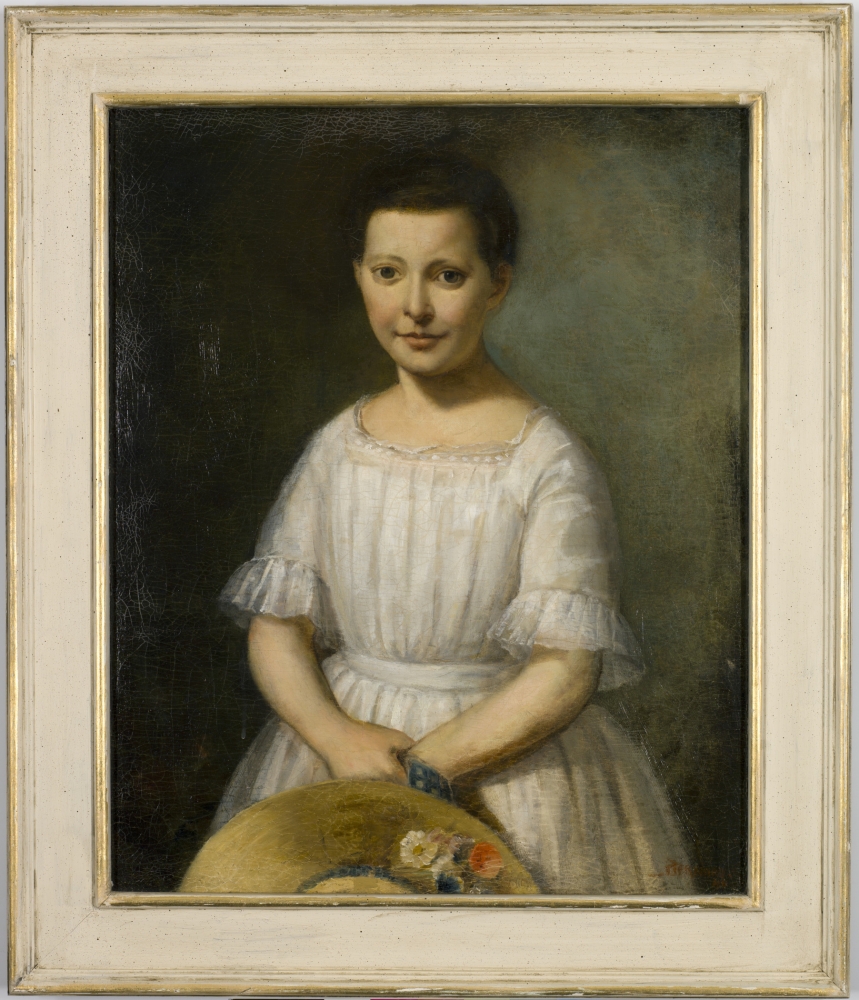
Girl with a straw hat; 1862–1872; by François Bernard; 2008.0329.1
FIRST PLACE
A Spotless White Dress Amidst a Stained World
by Libby Stassi, 10th grade
Academy of the Sacred Heart, New Orleans, LA
In my white dress, sewn with lace,
My portrait is painted, I stand up straight.
Outside these walls, away from my spotless dress,
Souls are sold in chains and worked without rest.
Away from my blooming flowers and subtle smile,
Mothers kiss their babies, afraid they won’t see them for a while.
People are torn from their homes and loaded on ships,
But I just sit in silence, as my portrait is equipped.
Half of my nation cries out for justice and human dignity,
While the others worry about the income of their family.
Their voices echo, and change is brewing
But I just sit right here, foolishly smiling.
Men roam free, in pursuit of dreams,
But I am bound by societal means.
My mother, grandmother, and great-grandmother begged for a voice,
But I sit here, in my white dress, not making any noise.
My brother learns to read, write, hope, and love,
While my sister and I, zipping up our white dresses, allow our dreams to be shoved.
I wonder of daughters, yet to come,
Will they inherit this world undone?
I wonder about families that were torn apart,
Will they finally see freedom and a world with heart?
SECOND PLACE
Memento Mori
by Madeline Colona, 9th grade
Hammond High Magnet School, Hammond, LA
Not for the first time, my eyes skitter over the girl before me. No one would call her a great beauty, but it is plain to see that she is graced with a certain sincerity of character, even in death. She is propped upright against a high, slender stool, painstakingly arranged so as to replicate life. Her ebony hair is pulled into a simple updo. She wears a humble linen dress, and a blue ribbon is tied between her pale hands and her favorite straw hat, as if she clamps its brim of her own accord. I almost believe she is peacefully asleep.
I intend to imbue Charlotte’s image with all of her loveliest qualities in life, as her heartbroken parents had requested, so that they might preserve her memory forevermore, untainted by malaria. Four returns to the easel are required before Charlotte’s likeness is perfected. I sculpt the girl’s base features, only altering what I must. I brush a slight rosy tint into her cheeks, and omit the curvature from her spine that exposes the stool supporting her. Finally, I remove the canvas from the easel, surveying what I wrought. And I nod. It is a small token to John and Adelaide, but it is the best that I have to offer.
THIRD PLACE
Portrait of a Girl Named Halesia
by Rory Davis, 10th grade
Lycée Français de la Nouvelle-Orléans, New Orleans, LA
I didn’t know him very well. The man who wanted to paint my portrait. The man who had been staying at my father’s inn, a couple of hours away from the port of New Orleans. He told me that upon his arrival, he had seen me, cutting flowers from the gardens on the property. “Why me?” I had asked. Why would this man want to paint my portrait? “Your smile,” he said, “You had this smile on your face when I first saw you, one that felt calm yet mischievous. It is the type of smile that others should have the pleasure of being met with when they come to stay here.” That was all it took for me to agree to the portrait. In a few days time I was sitting, anxiously, for the painting. It was the first time I had ever done something like this. But there was something he asked me that had calmed my nerves. “The flower in your hat, it is the same that you had picked in the garden, non? What is it?” I smiled, answering, “It is my namesake, Halesia diptera.” He smiled slightly, and with a nod, began to sketch.

